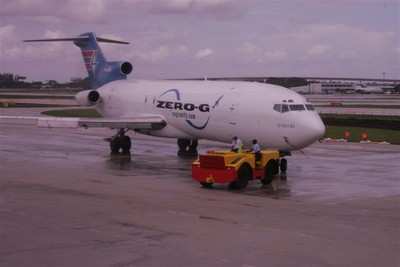Fri, Oct 07, 2011
Nine Experiments To Fly On Suborbital Rockets And Zero-G
Parabolic Aircraft
NASA has selected nine proposals to demonstrate new technologies
for the second set of payloads to fly on commercial suborbital
reusable launch vehicles and the Zero-G commercial parabolic
aircraft. NASA is using commercially available vehicles to carry
these technology demonstration payloads to help develop the U.S.
commercial reusable suborbital transportation industry.

NASA's Flight Opportunities Program provides test flights to
demonstrate and validate space technologies on airborne platforms
flying above 65,000 feet, the area known as "near space." The
program also supports parabolic flights that simulate brief periods
of microgravity or weightlessness. "We're moving out with a set of
payloads that can benefit from the proving ground of near space,"
Mike Gazarik, director of NASA's Space Technology Program at NASA
Headquarters in Washington said. "We're looking forward to
increasing the number of commercial flights and technology
demonstration payloads flown, with companies providing a viable
reusable flying science lab capability for researchers from all
across America."
Selected for flight on both a suborbital reusable launch vehicle
and the Zero-G aircraft is "Microgravity Multi-Phase Flow
Experiment for Suborbital Testing," team leader Kathryn Hurlbert of
NASA's Johnson Space Center in Houston.
Selected for flight on suborbital reusable launch vehicles:
- "Application of Controlled Vibrations to Multiphase Systems for
Space Applications," Ricard Gonzalez-Cinca, Universitat Politecnica
de Catalunya, Barcelona, Spain, and Richard Tyson, University of
Alabama in Huntsville
- "Environmental Monitoring Suite on Suborbital Reusable Launch
Vehicles," H. Todd Smith, and Lars P. Dyrud, Johns Hopkins
University Applied Physics Laboratory, Laurel, MD.
- "Measurement of the Atmospheric Background in the Mesosphere as
a Pre-cursor to Astronomical Observations," Sean Casey, USRA/SOFIA,
Moffett Field, CA.
- "RF Gauging of the Liquid Oxygen Tank on a Reusable Launch
Vehicle," Gregory Zimmerli, NASA's Glenn Research Center,
Clevelandm OH.
Selected for parabolic flight aboard the Zero-G aircraft:
- "Assessing Vestibulo-Ocular Function and Spatial Orientation in
Parabolic Flight," Mark Shelhamer, Johns Hopkins University School
of Medicine, Baltimore, MD.
- "Evaluation of a Medical Chest Drainage System Functional in
the Microgravity Environment," C. Marsh Cuttino, Orbital Medicine,
Inc., Richmond, VA.
- "Autonomous Cell Culture Apparatus for Growing 3-Dimensional
Tissues in Microgravity," Zarana Patel and Janice Huff of Johnson
and Colin Pawlowski of Yale University
- "A demonstrated application of a cost effective and novel
platform for non-invasive acquisition of physiologic variables from
spaceflight participant candidates," Ravi Komatireddy, University
of California at San Diego and West Wireless Health Institute of
San Diego, CA.

The Zero-G aircraft flights are expected to take off in April
2012 from Ellington Field in Houston. The suborbital reusable
launch vehicle payloads are expected to fly on vehicles produced by
Armadillo Aerospace, Masten Space Systems, Near Space Corporation,
UP Aerospace, Virgin Galactic, Whittinghill Aerospace, or XCOR
Aerospace. NASA selected the seven companies in August to integrate
and fly space technology payloads. The suborbital reusable launch
vehicle payload flights tentatively are scheduled to begin in early
2012.
NASA selected the proposals following an announcement of fight
opportunities issued last December. NASA called for proposals that
demonstrate or mature new technology payloads using parabolic
aircraft or suborbital reusable launch vehicles for reduced gravity
or near-space flights. The announcement will remain open until
December 31, 2014.
More News
DETRESFA (Distress Phrase) The code word used to designate an emergency phase wherein there is reasonable certainty that an aircraft and its occupants are threatened by grave and i>[...]
Aero Linx: The International Association of Missionary Aviation (IAMA) The International Association of Missionary Aviation (IAMA) is comprised of Mission organizations, flight sch>[...]
Also: EP Systems' Battery, Boeing SAF, Repeat TBM 960 Order, Japan Coast Guard H225 Buy Despite nearly 100 complaints totaling millions of dollars of potential fraud, combined with>[...]
Also: Viasat-uAvionix, UL94 Fuel Investigation, AF Materiel Command, NTSB Safety Alert Norges Luftsportforbund chose Aura Aero's little 2-seater in electric trim for their next gli>[...]
Also: Moya Delivery Drone, USMC Drone Pilot, Inversion RAY Reentry Vehicle, RapidFlight UAVOS has recently achieved a significant milestone in public safety and emergency services >[...]
 ANN's Daily Aero-Term (04.26.24): DETRESFA (Distress Phrase)
ANN's Daily Aero-Term (04.26.24): DETRESFA (Distress Phrase) ANN's Daily Aero-Linx (04.26.24)
ANN's Daily Aero-Linx (04.26.24) Airborne 04.22.24: Rotor X Worsens, Airport Fees 4 FNB?, USMC Drone Pilot
Airborne 04.22.24: Rotor X Worsens, Airport Fees 4 FNB?, USMC Drone Pilot Airborne 04.24.24: INTEGRAL E, Elixir USA, M700 RVSM
Airborne 04.24.24: INTEGRAL E, Elixir USA, M700 RVSM Airborne-NextGen 04.23.24: UAVOS UVH 170, magni650 Engine, World eVTOL Directory
Airborne-NextGen 04.23.24: UAVOS UVH 170, magni650 Engine, World eVTOL Directory




